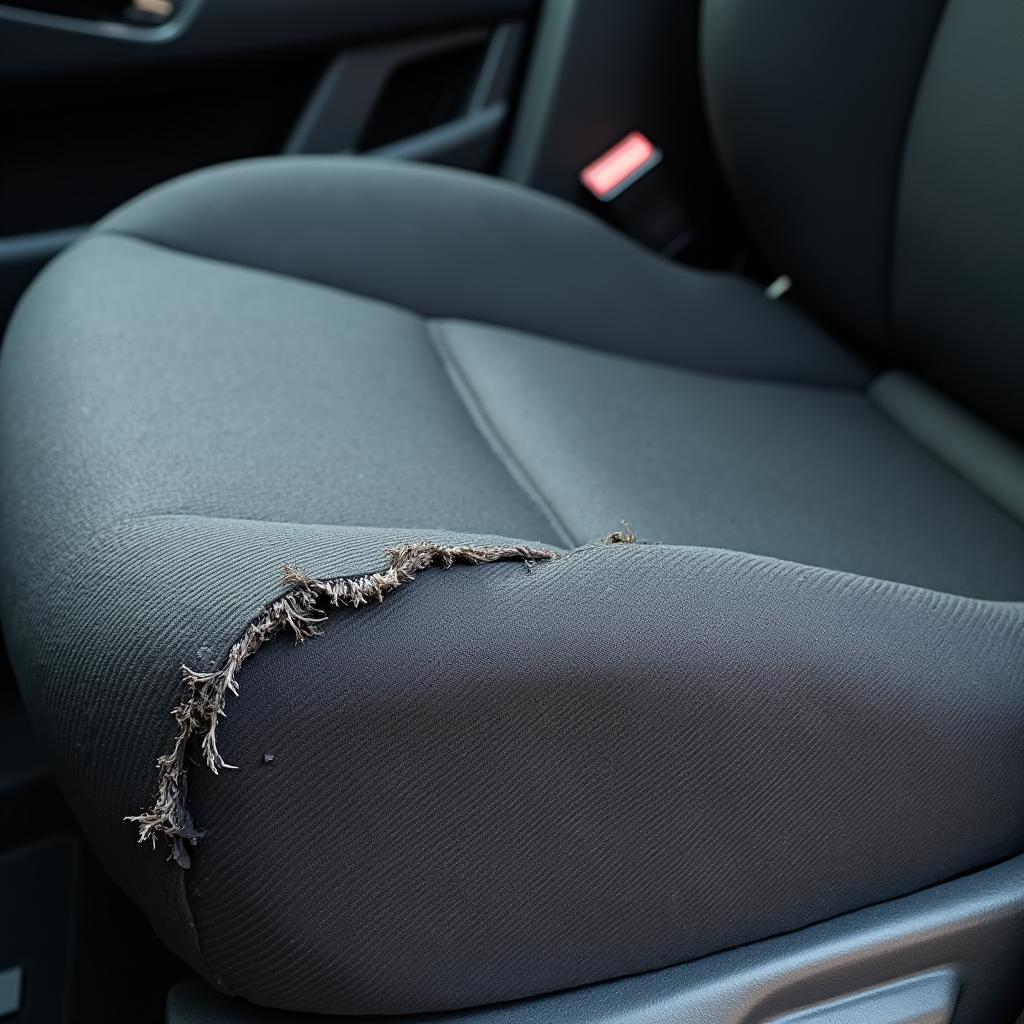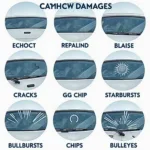Torn cloth car seats are an unsightly nuisance. Whether it’s from wear and tear, sharp objects, or accidental spills, a tear in your car’s upholstery can detract from the overall look of your vehicle. The good news is that you don’t always have to spend a fortune on professional repairs. With a little patience and the right materials, learning how to repair torn cloth car seats can be a manageable DIY project.
Assessing the Damage: What You’ll Need
Before you begin, it’s important to assess the severity of the tear. Small rips and tears can often be fixed with simple methods, while larger holes might require more advanced techniques.
Here’s a basic list of materials you might need:
- Cleaning supplies: A vacuum cleaner with crevice attachment, microfiber cloth, rubbing alcohol
- Repair materials: Depending on the chosen method – fabric glue, iron-on patches, sub-patch material, upholstery thread, curved upholstery needle
- Matching fabric: If the tear is large, you might need a piece of matching fabric for patching. You can often find matching fabric at fabric stores or online, or even salvage some from a hidden area of your car’s upholstery.
Choosing the Right Repair Method
There are several effective methods for repairing torn cloth car seats, each suited to different types and sizes of damage:
1. Fabric Glue for Minor Tears and Fraying
For small tears or frayed edges, fabric glue offers a quick and straightforward solution. Choose a high-quality fabric glue designed for upholstery. Apply a small amount of glue to the edges of the tear, carefully aligning them. Use a piece of scrap fabric to protect the visible side of the upholstery while you press the edges together firmly. Allow ample drying time as per the glue’s instructions.
2. Iron-On Patches for Small to Medium Tears
Iron-on patches are readily available in various colors and sizes. This method is best suited for tears located on flatter seat surfaces. Select a patch slightly larger than the tear, making sure it matches your car’s interior fabric. Follow the instructions provided with the patch, usually involving ironing over a protective cloth for a specific duration.
3. Sewing for Larger Tears and Durability
For larger tears, sewing provides a more durable and long-lasting repair. This method is best suited for those comfortable with basic sewing techniques. You’ll need upholstery thread that matches your car’s interior and a curved upholstery needle for easier maneuverability.
Here’s a step-by-step breakdown of the sewing process:
- Trim any loose threads: Carefully trim any frayed edges around the tear using sharp scissors.
- Use a sub-patch (optional): For added strength, cut a piece of sub-patch material (such as canvas or heavy-duty fabric) slightly larger than the tear. Place this behind the tear, securing it with fabric glue.
- Thread your needle: Cut a length of upholstery thread and thread your curved needle. Tie a knot at the end of the thread.
- Begin sewing: Starting from the inside of the tear, push the needle through to the front, ensuring your stitches are small and even. Continue sewing along the edges of the tear, pulling the thread taut after each stitch.
- Knotting off: Once you’ve sewn around the entire tear, knot the thread securely at the back of the fabric.
4. Professional Upholstery Repair for Extensive Damage
For significant tears, holes, or damage that affects multiple parts of the seat, seeking professional upholstery repair is recommended. Experienced professionals have the tools, expertise, and matching fabrics to restore your car seats to pristine condition.
Preventing Future Tears
While repairs can address existing damage, prevention is always better than cure. Here are some tips to safeguard your car’s upholstery:
- Regular Cleaning: Vacuum your car seats frequently to remove dirt, crumbs, and other debris that can cause premature wear and tear.
- Protective Covers: Consider using seat covers, especially if your car sees frequent use or you transport children and pets.
- Careful Entry and Exit: Be mindful when getting in and out of your car to avoid catching clothing or accessories on the seats.
- Address Spills Promptly: Clean up spills immediately to prevent staining and damage to the fabric fibers.
Torn Cloth Car Seat Repair: FAQs
Here are some commonly asked questions about fixing tears in cloth car seats:
Can I use super glue to fix a car seat tear?
While tempting, super glue isn’t ideal for upholstery repairs. It dries rigidly, making it prone to cracking and peeling over time. Fabric glue or upholstery glue is specifically designed for fabric flexibility and durability.
How much does professional car upholstery repair cost?
Professional repair costs vary widely depending on the extent of the damage, type of fabric, and location. It’s best to obtain quotes from reputable upholstery shops for accurate pricing.
How can I find matching fabric for my car’s interior?
You can often find matching fabric at fabric stores, online retailers specializing in automotive fabrics, or even salvage a piece from a hidden area of your car’s upholstery, such as under the seat or inside the trunk.
Conclusion
Repairing torn cloth car seats can seem daunting, but with the right approach, you can restore your car’s interior to a presentable condition. By carefully assessing the damage and choosing the appropriate repair method, you can save on costly professional repairs while ensuring a successful outcome.
For expert advice and top-quality car repair solutions, feel free to contact us via WhatsApp: +1(641)206-8880 or Email: [email protected]. Our team is available 24/7 to assist you. You can also learn more about how to repair a hole in cloth car seat in our dedicated guide. For leather car seat repair, refer to our comprehensive resource on do it yourself leather car seat repair. And if you’re dealing with a hole in your car seat fabric, explore our detailed guide on how to repair hole in car seat fabric. For vinyl and faux leather seat repairs, we have specific guides available on how to repair vinyl car seat and how to repair faux leather car seat respectively.



